What is a typical Chinese dinner?
When you think about a typical Chinese dinner, vibrant flavors, a mix of textures, and communal dining come to mind. In China, dinner is often the main meal of the day, filled with variety and an array of dishes that cater to all tastes, making the dining experience both enjoyable and communal.
Chinese dinners typically consist of a main course complemented by several side dishes, including rice or noodles, stir-fried vegetables, and meats or tofu. Here is what you can expect at a classic Chinese dinner:
Core Components of a Chinese Dinner
1. **Staple Dishes**: Rice or noodles are essential to any Chinese dinner. They serve as filler, soaking up the flavors from the other dishes.
2. **Vegetable Dishes**: Stir-fried or steamed vegetables are common and add both color and nutrients. Common choices include bok choy, broccoli, and green beans.
3. **Protein Sources**: Dishes with meat, fish, or tofu provide protein. Popular meats include chicken, beef, pork, and fish, prepared in a variety of styles like braising, steaming, or stir-frying.
4. **Soups**: A light soup can precede or accompany dinner. Famous varieties include hot and sour soup and wonton soup, adding warmth and flavor to the meal.
5. **Sauces and Seasoning**: Flavor is key in Chinese cuisine, so sauces like soy sauce, hoisin sauce, and chili oil are frequently used to enhance the taste of the dishes.
Cooking Methods and Styles
Cooking techniques play a significant role in creating the flavors of a typical Chinese dinner. Here are some popular methods:
- Stir-frying: Quick cooking over high heat, allowing ingredients to retain their color and crunch.
- Steaming: A healthy method that preserves flavors and nutrients, perfect for vegetables and seafood.
- Braising: A slow-cooking technique, often used for meats, ensuring tenderness and depth of flavor.
- Boiling: Common for soups, allowing ingredients to meld together for a hearty flavor.
A Communal Experience
One of the defining features of a Chinese dinner is the concept of shared dishes. Rather than individual plates, you will find dishes placed in the center of the table, from which everyone serves themselves. This practice not only fosters a sense of community but also allows guests to sample a variety of flavors during the meal.
Examples of Typical Dishes
To give you a clearer idea of what to expect, here is a list of popular dishes you might find at a typical Chinese dinner:
| Dishes | Description |
|---|---|
| Kung Pao Chicken | A spicy stir-fry dish made with chicken, peanuts, and vegetables. |
| Peking Duck | Crispy-skinned duck served with pancakes, hoisin sauce, and scallions. |
| Mapo Tofu | A spicy dish featuring soft tofu and ground meat in a rich, fragrant sauce. |
| Chow Mein | Stir-fried noodles with vegetables and proteins, often topped with soy sauce. |
| Dumplings | Wheat-based dough filled with meat or vegetables, steamed or fried. |
Regional Variations
Chinese cuisine is incredibly diverse, with regional variations offering unique flavors and dishes. For example:
- Cantonese Cuisine: Famous for dim sum and sweet flavors.
- Spicy Sichuan Cuisine: Known for bold flavors and the signature spicy kick.
- Beijing Cuisine: Focuses on roasted duck and imperial dishes.
- Shanghai Cuisine: Renowned for its freshwater fish and sweet dishes.
A typical Chinese dinner is a vibrant, flavorful affair centered around communal dining and shared dishes. The emphasis on fresh ingredients, various cooking methods, and regional specialties makes each meal a unique experience worth savoring.
For more insights into traditional Chinese dining experiences, visit China Highlights and Chowhound. Discover the vast array of flavors that define Chinese cuisine and the joy of dining in a shared setting.
The significance of rice in Chinese meals
Rice is a staple food in Chinese culture, integral to meals across the country. It holds a central place at the dining table, symbolizing nourishment and abundance. Traditionally, Chinese dinners feature rice in various forms, serving as a base or accompaniment for many delicious dishes. Understanding the significance of rice can enhance your appreciation for Chinese cuisine and its traditions.
The Cultural Importance of Rice
In China, rice is more than just food; it’s a cultural symbol. It represents wealth, fertility, and sustenance. For many families, rice is the primary source of carbohydrates, forming the backbone of their daily diet. The character for rice (米) is even used in various Chinese sayings and expressions, emphasizing its importance in the culture.
Types of Rice Commonly Used
Chinese cuisine utilizes several varieties of rice, each with distinct characteristics, flavors, and textures. Here are some popular types:
- Jasmine Rice: Fragrant and slightly sticky when cooked, this variety is favored in southern China.
- Short-Grain Rice: Characteristic of northern China, this rice is plumper, making it sticky and easier to roll into balls.
- Long-Grain Rice: Often fluffy and separate when cooked, suitable for frying and serving alongside dishes.
- Brown Rice: Less processed than white rice, it holds more nutrients and has a nuttier flavor.
How Rice is Prepared
The preparation of rice in Chinese cuisine is crucial to its success as a meal component. Here’s a basic outline of how rice is typically cooked:
- Rinsing: Rice is thoroughly rinsed to remove excess starch, ensuring it cooks evenly and doesn’t become gummy.
- Soaking: Depending on the type, some rice is soaked for a short time to enhance texture and reduce cooking time.
- Cooking: Rice is cooked in a rice cooker or a pot, usually with water, adjusting the ratio according to the type of rice used.
- Steaming: In some dishes, rice can be steamed, especially when served with other ingredients like meats and vegetables.
Typical Role of Rice in a Chinese Dinner
In a typical Chinese dinner, rice serves as the foundation on which other dishes are built. You may find it being served with:
- Stir-fried Vegetables: Colorful and nutritious, these dishes balance the meal with fresh greens.
- Meat Dishes: From sweet and sour pork to spicy chicken, meats are often saucy, which pairs perfectly with rice.
- Soups: Many dinners include soups that can either be enjoyed separately or poured over the rice.
A Symbol of Togetherness
Rice also embodies family and togetherness. At social gatherings, friends and family come together to share meals that include rice. In Chinese culture, “to have rice” means to have food, indicating a sense of community. This custom fosters relationships and enhances the dining experience.
The Health Benefits of Rice
Rice is often praised for its health benefits. It’s gluten-free, easy to digest, and provides a good source of energy. Brown rice, in particular, is rich in fiber, which aids in digestion. However, it’s essential to consume rice in moderation as part of a balanced diet.
Exploring Rice Varieties Further
If you’re interested in diving deeper into the varieties and nutritional values of rice, consider visiting sites such as China Chef and The Rice Association. These resources provide useful information on all aspects of rice, from cultivation to culinary uses.
Understanding rice’s significance in Chinese meals offers you a glimpse into the heart of the culture. It’s not just about culinary practices; it reflects the values and way of life in Chinese society. Next time you savor a Chinese dinner, pay attention to this humble grain that brings flavors, traditions, and families together around the table.
Exploring common Chinese dinner dishes and their origins
When it comes to a typical Chinese dinner, you’re diving into a rich cultural experience filled with flavor, tradition, and variety. Chinese cuisine varies widely across regions, but certain dishes are commonly enjoyed during dinner. Let’s explore some popular dishes and their interesting origins.
Fried Rice
Fried rice is one of the most recognizable Chinese dishes. This dish was originally created to avoid food waste by frying leftover rice with various ingredients. Typically, it includes vegetables, eggs, and protein options such as chicken or shrimp. In restaurants around the world, it has become a staple, yet it holds deep roots in Chinese households. Using soy sauce and sesame oil adds depth and a savory flavor to this beloved comfort food.
Dumplings
Dumplings, known as “jiaozi,” have a long history that dates back over 1,800 years. Initially created by Zhang Zhongjing, a famous physician, dumplings were intended to be a nourishing food to ward off winter ailments. Today, they are a symbol of wealth and prosperity, often served during festivities. These pockets of dough are usually filled with meat, vegetables, or seafood and can be steamed, boiled, or pan-fried.
Kung Pao Chicken
Originating from the Sichuan province, Kung Pao Chicken is a stir-fried dish made with diced chicken, peanuts, and vegetables. The dish gets its name from a 19th-century governor named Ding Baozhen, who was known as “Kung Pao.” It combines the heat of Sichuan peppercorns with the sweetness of soy sauce and the crunch of peanuts, creating a delightful balance of flavors.
Hot Pot
Hot Pot is not just a dish but a dining experience. This communal meal allows diners to cook their ingredients right at the table in a bubbling pot of broth. Traditionally enjoyed in colder months, hot pot dates back to the Han dynasty. You can customize your hot pot with a variety of sliced meats, seafood, and an array of vegetables, making it a beloved choice among families and friends.
Mapo Tofu
Mapo Tofu is a classic dish from Sichuan cuisine, known for its bold flavors and spicy profile. It consists of tofu set in a spicy sauce made from doubanjiang, fermented broad bean chili paste, and often includes ground pork or beef. The dish is named after a woman, known as “Mapo,” who was said to have invented the recipe for her delivery cart. If you enjoy bold and spicy flavors, Mapo Tofu is a must-try.
Peking Duck
Peking Duck is perhaps one of the most famous Chinese dishes globally. This dish originated from Beijing and has a history stretching back over 600 years. Known for its crispy skin and tender meat, Peking Duck is often served with pancakes, hoisin sauce, and sliced cucumbers. The traditional method of preparing it involves air-drying and roasting the duck until the skin is golden brown and crispy.
Sweet and Sour Pork
This dish is colorful and combines pork with a delightful sweet-and-sour sauce. Originating from Cantonese cuisine, its unique flavor comes from the use of vinegar and sugar. In the West, it has gained immense popularity and is frequently found on menu offerings in Chinese restaurants. The vibrant mix of bell peppers and pineapple adds freshness and texture.
Other Notable Dishes
- Chow Mein: Stir-fried noodles with meat and vegetables.
- Szechuan Chicken: Known for its spicy and bold flavors.
- Egg Drop Soup: A simple soup made with beaten eggs and seasoned broth.
Chinese dinners are not just about the food; they are also about the experience, community, and sharing. The dining aspect reflects traditions, family bonds, and celebrations. Check out Chinese Food World for more insights into authentic Chinese dishes and recipes.
As you explore these dishes, you will discover not only unique flavors but also rich stories from China’s long culinary history. Each dish represents a culinary journey that has evolved over centuries, reflecting China’s diverse regions and cultures.
Knowing these popular dishes may inspire you to try your hand at Chinese cooking or to seek out an authentic Chinese restaurant to enjoy a traditional meal. Embrace the flavors and stories behind them as you savor a typical Chinese dinner.
The role of family and sharing in Chinese dining culture
In Chinese culture, dining is more than just a meal; it embodies a way of life that emphasizes family, sharing, and community. This cultural perspective shapes not just what people eat, but how they behave around the dinner table. Families typically gather around for meals, creating a bond that goes beyond food. This unique approach plays a significant role in the importance of family connections in Chinese society.
Eating as a family is a cherished tradition in China, with many families striving to have dinner together each evening. This practice offers more than just nourishment. It serves as an opportunity for family members to reconnect, share their day’s experiences, and strengthen familial ties. In this communal setup, each dish represents a piece of the family’s shared history and culture. This tradition fosters a sense of belonging and warmth, reminding everyone of the threads that bind them together.
At a typical Chinese dinner, a variety of dishes are presented. During these meals, a common approach is to prepare multiple dishes that everyone shares, rather than individual plates for each person. This concept of sharing food enhances communication and interaction among family members. Typically, you might find an array of items such as:
- Stir-fried vegetables
- Meats like chicken, pork, and duck
- Fish, often served whole for good luck
- Rice or noodles as staple carbohydrates
- Dumplings, especially during festive occasions
The act of sharing meals goes deeper than just culinary enjoyment; it is symbolic. Each dish has its meaning, often linked to prosperity, happiness, and harmony. For example, fish represents abundance, while dumplings symbolize wealth, as their shape resembles ancient Chinese currency. This symbolism encourages family members to reflect on their values and share aspirations for the future.
When it comes to the actual act of dining, etiquette plays an essential role. It is customary to wait for the eldest member to start eating before everyone digs in. This practice reinforces respect for elders and denotes family hierarchy. Many families also follow the “lazy Susan” principle, where dishes are placed on a rotating tray in the center of the table. This way, everyone can reach for whatever they desire without feeling obligated to serve themselves first.
Moreover, the beverage of choice often complements the meal. Tea holds a special place in Chinese dining culture. Serving tea is a gesture of respect and hospitality. During meals, family members might enjoy different types of tea, which further enhances the dining experience. Tea culture in China is vast and varied, connecting back to the rich history of the country.
Chinese dinner gatherings also extend beyond the immediate family. It is common to see grandparents, aunts, uncles, and cousins joining together. During holidays or festivals, these gatherings can expand even further, including friends and neighbors. The extended family and community aspects serve to reinforce social bonds and create a network of support among members. In this setting, sharing food becomes a way to share joy, laughter, and companionship.
Even in modern contexts, when families may find it challenging to dine together due to hectic schedules, the spirit of sharing remains strong. Many families incorporate technology into their meals, using video calls to stay connected over dinner despite physical distance. This adaptation shows the enduring importance of family ties and community, reflecting how tradition continues to evolve in contemporary life.
The role of family and sharing in Chinese dining culture is profound. It emphasizes connections, traditions, and values that stretch far beyond mealtime. By cherishing these moments, families cultivate bonds that can last a lifetime. Whether during daily dinners or festive gatherings, the significance of shared meals is a hallmark of Chinese culture, instilling a sense of love, belonging, and community for all who partake.
For an in-depth look into the cultural aspects of dining in China, visit China Culture which provides a wealth of information about traditions and practices.
To explore more about family and social interactions during dining experiences, consider reading resources from China Travel that dive into various regions and their unique dining customs.
Traditional Chinese dinner etiquette to follow
Dining in China is about more than just the food; it’s also significantly influenced by tradition and etiquette. Understanding Chinese dinner etiquette can enhance your dining experience, whether you’re attending a formal banquet or enjoying a casual meal with friends or family.
One of the first aspects of traditional Chinese dinner etiquette is the seating arrangement. Traditionally, the most honored guest is seated farthest from the entrance, usually at the head of the table. You, as a guest, should wait for the host to invite you to sit before taking your place. If you’re unsure where to sit, simply observe the other guests or follow the lead of the host.
As you start your meal, it’s important to note that chopsticks play a crucial role. Do not stick chopsticks upright in a bowl of rice, as this resembles the incense offered at funerals. Instead, place them on the chopstick rest when not in use. If you struggle with chopsticks, don’t be shy; it’s perfectly acceptable to ask for a fork.
When it comes to serving food, the Chinese dining style typically involves shared dishes. Each meal consists of a variety of dishes placed in the center of the table, and everyone serves themselves. Here are some tips for sharing meals:
- Use the serving utensils provided to take food from communal dishes.
- Avoid reaching over other diners to grab food; instead, politely ask if you can pass a dish closer to you.
- Don’t take the last piece of food unless the host insists; declining is a sign of humility.
While dining, it’s customary to wait for the host to signal the start of the meal. Usually, this is initiated by a toast or by saying “吃饭 (chīfàn),” meaning “let’s eat.” If you’re unsure when to begin, simply follow the lead of your host. Additionally, it’s polite to express gratitude for each dish as it’s served.
Speaking of drinks, when someone offers you a beverage, particularly tea, accept graciously. Pouring tea for others is a sign of respect. Use both hands when receiving or passing drinks or food, as this shows your appreciation. Be mindful to not pour your own drink; instead, allow others to fill your glass while you reciprocate the gesture.
When it comes to mealtime conversations, engaging in light gossip or discussing the food is encouraged. Avoid overly controversial topics, as the dinner should remain enjoyable for everyone. Be attentive, respond to others, and ask questions to facilitate a warm atmosphere. It’s also polite to express pleasure about a dish, which encourages hosts to offer more of it.
As the meal progresses, one should also be aware of nesting bowls and plates. If you’re done eating but don’t wish to leave the impression that you’re finished with the meal, it’s customary to leave a small amount of food on your plate. This indicates you’ve had enough without offending your host. On the other hand, finishing all the food can imply that the host did not provide enough for you.
When the meal has concluded, the host will typically make the final toast. It’s polite to stand if invited and to raise your glass while clinking it with those around you. Always ensure that your glass is lower than those of senior guests as a sign of respect. After the meal, thank the host and compliment the meal to express your appreciation for their hospitality.
Understanding traditional Chinese dinner etiquette can significantly enhance your dining experience. Practicing these customs not only shows respect for Chinese culture but also enriches your personal interactions. If you wish to delve deeper into Chinese dining customs, you might find resources such as China Highlights helpful.
Seasonal ingredients used in Chinese cooking
Chinese cooking is a vibrant tapestry woven from a rich history of flavors and techniques. One of the most compelling aspects of this cuisine is its emphasis on seasonal ingredients. When you cook with what’s in season, you not only enhance the flavor of your dishes but also prioritize nutrition and sustainability. By incorporating seasonal foods, you can create meals that reflect the natural cycles of agriculture, making the dining experience more connected to the environment.
Each season in China brings a unique selection of ingredients that influences traditional recipes. Here’s an overview of some common seasonal ingredients used in Chinese cooking, and how they contribute to the cuisine’s diversity.
- Spring: This season is celebrated for its vibrant greens and fresh flavors. Ingredients like asparagus, snap peas, and spring onions emerge, ideal for light and refreshing dishes. Common dishes include stir-fried vegetables and dumplings filled with seasonal herbs.
- Summer: Summer in China is marked by an abundance of fruits and vegetables. Tomatoes, cucumbers, and bell peppers shine during this time. You’ll find dishes like cold noodle salads featuring these ingredients, perfect for warm-weather meals. Fruits such as lychees and peaches are also enjoyed fresh or as a dessert.
- Autumn: The cooler temperatures bring hearty ingredients like squash, sweet potatoes, and mushrooms. Autumn is the time for robust flavors, making it a great season for soups and stews, such as pumpkin soup and wild mushroom stir-fry. Apples and pears also come into play, often used in desserts or eaten fresh.
- Winter: During the winter months, root vegetables like carrots, turnips, and daikon radishes are plentiful. These ingredients create warmth and comfort in dishes like braised meats and stews. Winter in China also features preserved ingredients, including pickled vegetables, which add flavor and depth to meals.
These seasonal ingredients into your meals can elevate your cooking and offer unique flavors that reflect the time of year. Let’s take a deeper dive into some specific ingredients by season.
| Season | Key Ingredients | Typical Dishes |
|---|---|---|
| Spring | Asparagus, snap peas, spring onions, spinach | Dumplings, stir-fried greens |
| Summer | Cucumbers, tomatoes, bell peppers, seasonal fruits | Cold noodles, stir-fried vegetables |
| Autumn | Squash, sweet potatoes, mushrooms, apples, pears | Stews, roasted vegetables |
| Winter | Carrots, turnips, daikon radishes, preserved vegetables | Braised meats, hearty soups |
As you explore seasonal ingredients, consider how they can impact not just your meals but your overall well-being. For example, fresh vegetables are not only tastier but also packed with nutrients, which contribute to a healthier lifestyle. When you cook with what’s in season, it often means your food is more flavorful and offers a better texture, transforming your culinary creations into something exceptional.
Detiginto various seasonal ingredients, you might find that the charm of Chinese cooking lies in its attention to detail and respect for nature’s rhythm. This ethos extends beyond just what’s available at your local market; it encourages you to appreciate the facets of cooking that mirror the seasons, such as the textures, flavors, and cooking methods that change with each turn of the year.
For anyone looking to delve deeper into the world of seasonal cooking, numerous resources are available. Explore websites like China Culinary for inspiring recipes and tips on utilizing seasonal ingredients. Additionally, the Beijinger provides city-specific ingredients that can enhance your experience during every visit to local markets.
You might also enjoy local culinary workshops or events focusing on seasonal themes. This not only helps you connect with the food but also encourages a sense of community and shared culinary heritage. By choosing to cook with seasonal ingredients, each meal becomes not just a dish but a celebration of time and nature.
How regional differences shape Chinese dinner experiences
Chinese cuisine is a tapestry rich in history, culture, and flavors. One way to appreciate this culinary diversity is by understanding how regional differences shape Chinese dinner experiences. Across the vast lands of China, each region offers distinct specialties that reflect local ingredients, climate, and traditions. Let’s explore the various flavors and styles that define typical Chinese dinners.
Northern China
Northern Chinese cuisine is characterized by hearty dishes, often featuring wheat-based foods. The cold climate influences meals, making warming dishes essential. Some favorites include:
- Dumplings (Jiaozi): These are filled with meat and vegetables, boiled or pan-fried, and are a staple during any family gathering.
- Hand-pulled Noodles: Often served in savory broths, these noodles symbolize longevity and are popular in many dining settings.
- Hot Pot: A communal style of cooking where diners cook their own ingredients in a bubbling pot of broth right at the table.
Eastern China
Eastern China, especially areas like Shanghai, is known for its delicate and sweet flavors. Here, you will find an emphasis on freshness and seasonal produce. Popular dinner items include:
- Sweet and Sour Pork: This iconic dish captures the balance of flavors prevalent in the region.
- S steamed Buns (Baozi): These fluffy buns can be filled with a variety of meats and vegetables, making them versatile and enjoyable.
- Wonton Soup: This comforting dish is frequently found in family dinners, showcasing thin wrappers filled with minced pork.
Southern China
Southern Chinese cuisine, especially from regions like Guangdong (Canton), is often recognized for its vibrant dishes and emphasis on freshness. A typical dinner might include:
- Dim Sum: A meal consisting of small bite-sized portions served in steamer baskets, perfect for sharing with family and friends.
- Stir-fried Vegetables: With an emphasis on seasonal vegetables, light stir-frying allows the natural flavors to shine.
- Rice Dishes: Steamed rice is a staple that accompanies nearly every meal, acting as a neutral base to balance richer dishes.
Western China
Western China, particularly Xinjiang and Sichuan, is known for its bold and spicy flavors. The food often incorporates heat and aromatics that create memorable dinner experiences. Key elements of a typical dinner are:
- Spicy Hot Pot: Unlike its northern counterpart, the southwestern version emphasizes chili and rich spices alongside fresh ingredients.
- Mapo Tofu: A famous Sichuan dish that mixes silken tofu with strong spices, beans, and a distinctive numbness from Sichuan pepper.
- Grilled Lamb Skewers: Commonly found in Xinjiang, these skewers, seasoned with spices, are a popular street food often enjoyed during meals.
It is important to note that regional dishes reflect not only the geography but also the cultural history of the people. Festivals, local traditions, and even religious beliefs influence the types of dishes served, creating a rich tapestry for any dinner gathering.
Dining Culture
In addition to the variety in flavors, the dining culture plays a crucial role in shaping the experience of a typical Chinese dinner. Meals are often communal, with dishes placed in the center for everyone to share, promoting togetherness and familial bonds.
Here are some unique dining customs:
- Lazy Susan: Many tables are equipped with a rotating tray, allowing easy access to shared dishes.
- Inviting Guests: It’s common to invite family and friends over for dinner, showcasing hospitality and fostering connections.
- Serving Customs: The host often serves guests first, emphasizing respect and care in the dining experience.
The regional differences in Chinese cuisine create a delightful mosaic of flavors and dining traditions. Each meal represents not just food, but a rich cultural heritage tied to history and community. For those looking to experience authentic Chinese cooking, exploring these regions’ culinary offerings is an excellent place to start. For more insights into the nuances of Chinese cuisine, visit Chinese Cooking Demystified for recipes and cooking techniques.
Key Takeaway:
A typical Chinese dinner is a delightful exploration of flavors, traditions, and communal experiences that go far beyond just food. Central to nearly every meal is rice, a staple that symbolizes prosperity and sustenance in Chinese culture. It often serves as the foundation of a dinner, with a myriad of dishes surrounding it. This highlights the importance of rice not only as a food source but also as a cultural symbol that connects the family and the meal.
When you delve into common Chinese dinner dishes, you can discover rich histories behind favorites like Kung Pao Chicken, Peking Duck, and Mapo Tofu. Each dish tells a story of its regional origins and the people who made them famous. For example, Sichuan cuisine is known for its bold flavors and spice, reflecting the agricultural abundance of the area. Conversely, Cantonese dishes often lean towards freshness, showcasing the importance of seasonal ingredients. The availability of these ingredients also varies by region, adding unique twists to traditional meals based on local harvests.
Family and sharing play a vital role in the dining experience. Chinese dinners often consist of multiple dishes laid out on a circular table for everyone to enjoy. This communal style not only encourages you to share food but also to bond with family members over a meal, fostering connections that go beyond mere sustenance.
Moreover, understanding traditional Chinese dinner etiquette can enhance your dining experience significantly. Knowing how to use chopsticks properly, when to serve others, and how to show appreciation can create a sense of harmony and respect at the table.
A typical Chinese dinner is a symphony of flavors, traditions, and familial bonds. Whether you are savoring the warmth of rice or the complex history behind each dish, you are participating in a rich cultural heritage that celebrates unity, respect, and seasonal splendor. Embracing these aspects of a Chinese dinner can deepen your appreciation for this diverse cuisine and the cherished moments shared around the table.
Conclusion
A typical Chinese dinner is a vibrant tapestry of flavors, textures, and traditions that reflect the rich cultural heritage of China. Central to this experience is rice, which serves as a staple and symbol of sustenance in Chinese meals. Beyond rice, the wide variety of common dishes—ranging from sweet and sour pork to spicy Szechuan chicken—illustrates the diverse culinary landscape shaped by historical and regional influences.
Family plays a vital role in Chinese dining culture, with meals often designed for sharing, fostering a sense of togetherness and community. The act of passing dishes around the table emphasizes connection and hospitality, essential values in Chinese society. Following traditional dining etiquette is equally important, guiding guests on how to respect the meal and each other, enhancing the dining experience.
The freshness and quality of seasonal ingredients are also pivotal, as they not only influence the dish’s flavor but also highlight the importance of sustainability and resourcefulness in Chinese cooking. Seasonal shifts can lead to entirely different dining experiences, showcasing local specialties and varied cooking styles that define different regions.
Understanding the elements of a typical Chinese dinner opens the door to appreciating the complexity and beauty embedded in each meal. As you explore these unique aspects, you gain insight into not just the food itself, but the values, traditions, and relationships that make dining in China a profoundly meaningful experience. Embrace the opportunity to share and enjoy this culinary journey, and you will find that every bite tells a story.
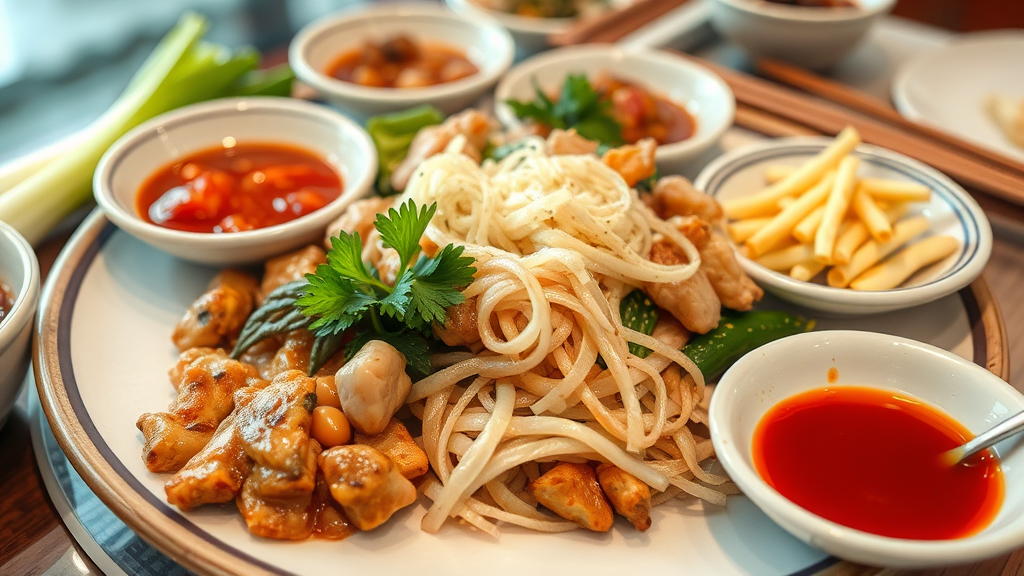


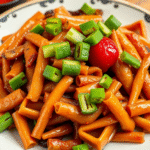
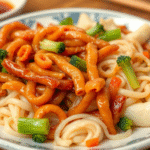
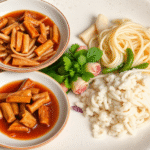
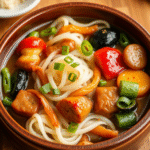
Leave a Reply